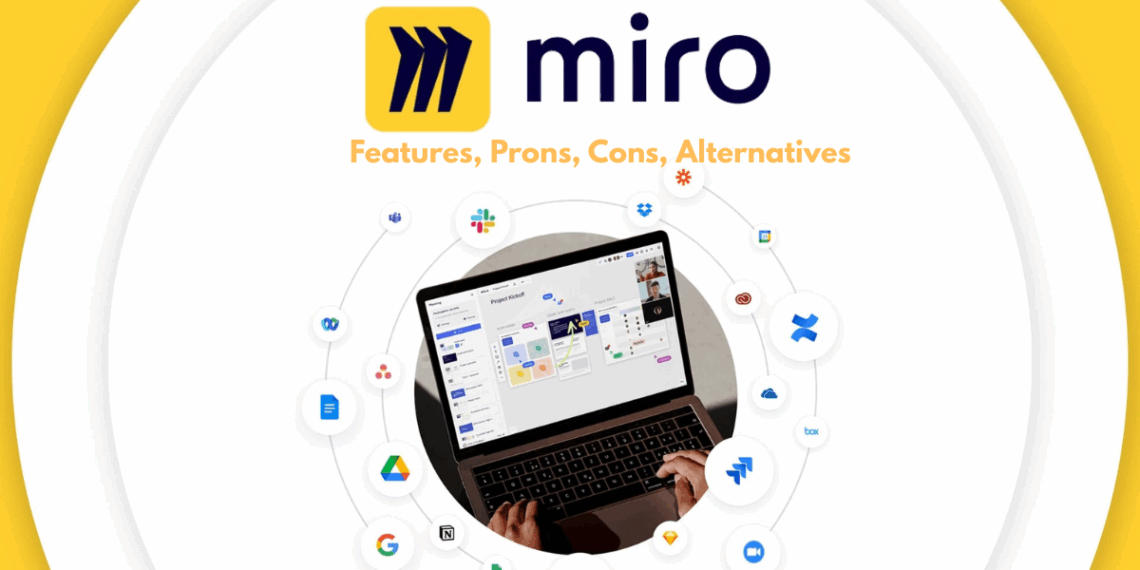In today’s fast-paced startup world, visual collaboration isn’t just a nice-to-have—it’s a necessity. Founders and early teams juggle remote work, rapid ideation, agile workflows, and cross-functional planning, often with limited resources. That’s where tools like Miro come in. Competing with the likes of FigJam, Mural, and Lucidspark, Miro has carved out a strong position as a visual collaboration hub for product teams, designers, marketers, and engineers. 🚀📈
In this review, we dive into what makes Miro more than just a digital whiteboard. Can it be the creative powerhouse your startup needs to accelerate innovation, align remote teams, and bring your big ideas to life? Let’s find out. 🌟
Miro Overview
Miro is an online visual collaboration platform designed to help teams brainstorm, plan, and execute ideas in a shared workspace. Originally launched as RealtimeBoard, Miro has evolved into a fully featured “innovation workspace” that supports everything from product roadmapping and UX wireframing to agile sprint planning, design sprints, team retrospectives, and investor pitch presentations. 📅🔄
Its user base exceeds 90 million globally, with startups forming a significant chunk—especially those embracing remote work and cross-functional collaboration. Miro has gained traction not only with product teams and designers, but also with marketers, engineers, and founders who need to align quickly around strategy and execution. Whether you’re mapping your go-to-market strategy, visualizing customer journeys, or running workshops with external stakeholders, Miro provides the flexibility to support a range of high-impact startup activities.
With integrations across popular tools like Jira, Slack, Figma, Notion, and Google Drive, Miro aims to be more than a whiteboard. It wants to be your startup’s visual command center—centralizing creative thinking, execution workflows, and team collaboration in one accessible platform.
Miro Key Features
Miro packs a rich toolkit tailored for the needs of fast-moving, visually oriented startup teams. ✨ From the moment you create a board, you’re stepping into a workspace designed to facilitate collaboration, ideation, and execution—all in one place. 💼 Below are the key features that make Miro a favorite among early-stage founders, product managers, designers, and engineers:
🌍 Infinite Canvas
A boundless digital space to map out ideas, build workflows, and connect concepts without limitations. Ideal for complex startup planning.
🤝 Real-Time & Async Collaboration
Supports both live interaction and asynchronous work with features like shared cursors, comments, and Talktrack video walkthroughs.
📚 Template Library
Over 300 templates tailored for use cases like Lean Canvas, MVP planning, journey mapping, and retrospectives—perfect for startups iterating fast.
🔗 Deep Integrations
Connect with tools like Jira, Trello, Slack, Figma, Google Workspace, and over 150 others to create seamless workflows.
🧪 Miro AI
Generate mind maps, cluster sticky notes, summarize comments, and even rewrite text using Miro’s growing suite of AI features.
📆 Agile Toolkits
Pre-built templates for Scrum, Kanban, sprint planning, and retrospectives make Miro a natural fit for agile product teams.
🌐 Guest & Public Access
Allow clients, advisors, or investors to join and interact on boards without paying for extra licenses (paid plans only).
🎓 Presentation & Workshop Tools
Use frames, timers, voting, and private mode to facilitate meetings, workshops, or investor pitches remotely.

Miro Pros and Cons
👍 Pros
- Excellent for remote and hybrid teams
- Huge template library for startup use cases
- Deep integrations with common startup tools
- Flexible for both real-time and async work
- Powerful support for agile teams
- Great initial experience with intuitive UI
👎 Cons
- Paid plans can get expensive as team grows
- Learning curve for advanced features
- Performance lag on large boards
- Limited PDF export quality
- Infinite canvas can become cluttered
- Advanced security features gated to higher plans
Considering Miro for Startups
Before jumping into a paid plan or integrating Miro into your core workflow, it’s essential to evaluate how well it aligns with your startup’s unique needs🚀. From team structure and growth stage to security requirements and learning capacity, these considerations will help you make a smarter, more confident decision. 🤔
📌 Is visual collaboration a core part of your workflow?
If your team relies heavily on brainstorming, diagramming, or agile planning, Miro’s visual-first approach can dramatically enhance clarity and speed.
💰 Do you have budget flexibility beyond free tools?
While the Free plan is solid for exploration, meaningful use typically requires a paid plan. Consider your willingness to invest in scalable collaboration tools.
🔗 Are integrations like Jira, Slack, and Figma essential?
If your team already uses popular tools like Jira for development or Figma for design, Miro’s integrations can unify your workflows and eliminate tool-switching friction.
👥 How large is your team, and how fast is it growing?
Miro’s per-user pricing can add up. Rapid team expansion may require a careful assessment of long-term subscription costs versus collaborative benefits.
📈 Do you need a tool that scales with your operations?
Miro’s structure supports everything from small project teams to enterprise-level workflows, making it suitable if you expect fast organizational growth.
🛡️ Are security & admin controls important for your data?
If your startup handles sensitive information or operates in regulated sectors, advanced security features like SSO and granular permissions (available in higher tiers) may be essential.
🎯 Will your team invest time in learning the platform?
To unlock Miro’s full potential, teams must go beyond sticky notes and templates. Are you ready to train your team to leverage powerful features like Talktrack, AI, and integrations?

Miro Plans and Pricing
Miro offers a Free plan plus tiered pricing per user per month. Here’s a comparison of the most relevant plans:
| Plan | Monthly Price per Seat | Key Features |
|---|---|---|
| Free | $0 | 3 editable boards, core integrations, basic collaboration tools |
| Starter | $8–$10 | Unlimited boards, private boards, visitors with edit, custom templates |
| Business | $16–$20 | Advanced integrations (Azure), Guests, SSO, Miro AI credits, admin tools |
Miro Promo Code / Startup Discount Info
Miro offers a Startup Program providing either $500 or $1,000 in credits 💸depending on eligibility. To qualify, startups must be early-stage (Series A or earlier), have fewer than 30 employees, and not be existing paid users. These credits help offset paid plan costs for 6–12 months, making it easier to adopt Miro during critical growth phases.🚀
Comparing Miro with Alternatives
| Feature | Miro | FigJam | Mural |
|---|---|---|---|
| Free tier🆓 | Yes (3 boards) | Yes | Yes |
| Sales pipeline tools💹 | No | No | No |
| Agile templates🤖 | Yes | Basic | Yes |
| UX design integration🖥️ | Strong (Figma) | Seamless | Moderate |
| Guest collaboration💕 | Yes (paid) | Yes (free) | Yes (paid) |
| Starting price💵 | $8/user/month | $3/user/month | $12/user/month |

FAQs
❓ Is Miro easy for non-technical teams to use?
Yes. The interface is visual and intuitive, with drag-and-drop tools and templates for common startup workflows.
❓ Does Miro work well with Jira, Slack, and Google Drive?
Absolutely. Miro integrates deeply with popular project and communication tools, reducing context switching.
❓ Are there hidden fees or upgrade surprises?
No hidden fees, but many features (e.g., unlimited boards, advanced integrations) require upgrading from the Free plan.
❓ Can external collaborators join without extra cost?
Yes, on paid plans you can invite visitors or guests with view/comment/edit access depending on plan level.
❓ How secure is Miro for IP and sensitive data?
Miro complies with major standards (SOC 2, GDPR) and offers encryption. SSO and advanced controls are only in higher plans.
❓ Does Miro work on mobile?
Yes, Miro offers a mobile app for both iOS and Android, though complex boards are easier to manage on desktop.
Final Thoughts
Miro is a powerful visual workspace that can bring structure, speed, and clarity to your startup’s chaotic early days. Whether you’re mapping out your MVP 🧪, coordinating product sprints 🏃♂️, or running investor pitch preps 💼, Miro helps create alignment across remote and cross-functional teams. For founders juggling product, design, and marketing, this centralization can save valuable time and reduce friction. 🌎
However, if budget constraints are tight or your use case is simpler—say, basic brainstorming or limited collaboration—other tools like FigJam might offer a leaner alternative. But if your team plans to grow quickly 📈, tackle complex workflows, or needs stronger integrations and workshop features, the Miro Startup Program becomes a strategic opportunity. With up to $1,000 in credits 💰, it’s an excellent way to test-drive a robust platform without immediate financial pressure. 🚀
💡If your startup is ready to build, brainstorm, and iterate at scale—with a tool that grows with you—Miro just might be your whiteboard of the future.










